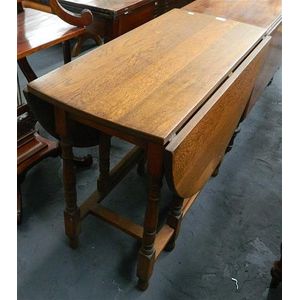Rustic Pine and Oak Trestle Stools - Long Pair
Pair of rustic pine and oak trestle form long stools, approx 266 cm long, 46 cm high
You must be a subscriber, and be logged in to view price and dealer details.
Subscribe Now to view actual auction price for this item
When you subscribe, you have the option of setting the currency in which to display prices to $Au, $US, $NZ or Stg.
This item has been sold, and the description, image and price are for reference purposes only.
- Trestle Table - The medieval table was usually a loose board, placed on removeable folding supports called trestles. In the 16th century, trestles fixed to the top of the table were introduced at each end of the frame, each resting on a broad base or foot, often connected and supported by one or two stretchers.
- Rustic - Rustic is defined as "of, relating to, or typical of country life or country people", and the items illustrated in this price guide accord with that definition.
But in the 18th and 19th century "rustic furniture" had a narrower definition. It referred to furniture where the framework was carved or moulded to resemble tree trunks and branches, and was usually for outdoor use. Rustic furniture was made in cast iron, wood, terracootta and concrete. Much of the Coalbrookdale company's cast iron furniture was of rustic design. - Oak - Native to Europe and England, oak has been used for joinery, furniture and building since the beginning of the medieval civilisation. It is a pale yellow in colour when freshly cut and darkens with age to a mid brown colour.
Oak as a furniture timber was superceded by walnut in the 17th century, and in the 18th century by mahogany,
Semi-fossilised bog oak is black in colour, and is found in peat bogs where the trees have fallen and been preserved from decay by the bog. It is used for jewellery and small carved trinkets.
Pollard oak is taken from an oak that has been regularly pollarded, that is the upper branches have been removed at the top of the trunk, result that new branches would appear, and over time the top would become ball-like. . When harvested and sawn, the timber displays a continuous surface of knotty circles. The timber was scarce and expensive and was used in more expensive pieces of furniture in the Regency and Victorian periods.
This item has been included into following indexes:
- stools, material - oak 125
- stools, type or function
Visually similar items

A 19th century oak drop leaf gate leg table
Sold by
in
for
You can display prices in $Au, $US, $NZ or Stg.

Pair of modern teak rustic long benches, standing on square tapering legs, each 195 cm long. 38 cm depth
Sold by
in
for
You can display prices in $Au, $US, $NZ or Stg.

Antique 18th French walnut and oak table desk, approx 91 cm wide
Sold by
in
for
You can display prices in $Au, $US, $NZ or Stg.

French Louis XV cherrywood farm house table, fitted with a single drawer, approx 75 cm high, 200 cm long
Sold by
in
for
You can display prices in $Au, $US, $NZ or Stg.
